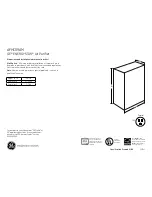
CyberOne EC DX IOM Manual
Symptom
Probable Cause
Recommendation
Noisy Compressor
a. Expansion valve stuck in open position
(abnormally cold suction line).
Ensure feeder bulb is tight on suction
line. Check operation and superheat.
b.
Worn or scarred compressor bearings.
Replace compressor.
c.
Broken compressor valve (compressor
knocking, suction pressure rises faster
than 2 lb/min after shutdown).
Replace compressor.
d.
Liquid slugging.
System overcharged. Reclaim excess
refrigerant.
e.
Scroll compressor not properly phased.
Phase correctly at main power source. Do not
rewire compressor.
Compressor Fails to Start
a. Temperature setpoint too high.
Adjust to desired temperature.
b.
Compressor internal overload protector
is open.
c.
Complete loss of refrigerant charge (low
pressure safety switch).
d.
Condenser pressure too high (high pres-
sure safety switch).
Check compressor for short circuit or ground.
Locate and repair leak. Recharge system.
Check condenser for obstructions.
e.
Minimum off time has not expired.
Wait for time to expire.
System Short of Capacity
a. Low refrigerant (indicated by bubbles in
sight glass).
b.
Expansion valve stuck or obstructed
(short cycling or continuous running).
Check for leaks. Repair and recharge
system.
Remove valve and clear obstruction or
replace valve.
c.
Clogged drier/strainer (feels cold).
Replace with new drier/ strainer.
d.
Reduced airflow.
Check belt tension, filters and clear evaporator
coil of debris.
Compressor Short Cycles
a. Low line voltage causing compressor to
overheat.
Check power source for cause of low line
voltage.
b.
Dirty or iced-over evaporator coil.
Defrost and/or clean coil.
c.
Reduced airflow (when applicable).
Check filter and fan speed.
d.
Lack of refrigerant.
Check for leak. Repair and recharge system.
e.
Short cycling of conditioned air.
1. Supply and/or return grilles are too close
together. Move farther apart.
2. Insufficient heat load. Add temporary heat
load to compensate.
f.
Remote temperature sensor is improperly
located.
Check for supply registers that may be too
close to the remote temperature sensor.
Relocate sensor if necessary.
36











































